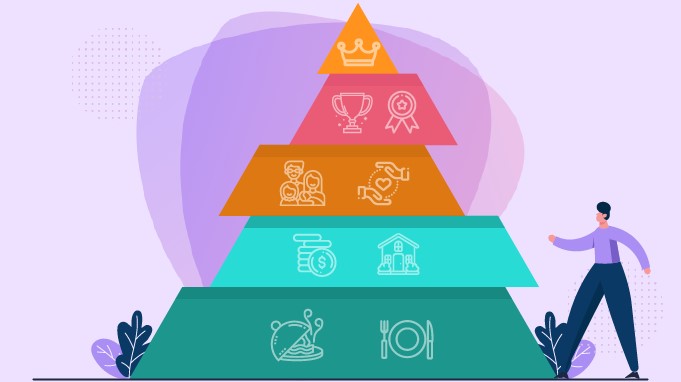Maslow’s Hierarchy of Needs is a psychological theory that explains human motivation through a tiered model of basic to complex needs. Abraham Maslow developed this theory in 1943, suggesting that unmet needs, arranged in a hierarchical order, motivate individuals. Understanding Maslow’s Hierarchy of Needs provides valuable insights into human behavior, helping businesses enhance engagement as well as satisfaction.
The Five Levels of Needs
People typically depict Maslow’s Hierarchy of Needs as a pyramid with five levels. Each level represents a category of needs that humans seek to fulfill. The lower levels of the hierarchy must be satisfied before individuals can focus on higher-level needs. This progression from basic to advanced needs is essential for understanding how to motivate and also support individuals effectively.
The first level of Maslow’s Hierarchy of Needs comprises physiological needs. These are the basic necessities for human survival, such as food, water, shelter, as well as clothing. Without meeting these fundamental needs, individuals cannot function properly, making them the most critical to address. Businesses must ensure that these basic needs are met to create a productive environment.
The second level of the hierarchy is safety needs, which include personal security, financial stability, health, and also well-being. People seek to protect themselves from harm as well as ensure their future security. In the workplace, providing a safe environment and job security is crucial for employee satisfaction. Additionally, clear policies and procedures can help employees feel more secure.
Social Needs and Belonging
The third level of Maslow’s Hierarchy of Needs is social needs, which encompass relationships, love, and belonging. Humans are inherently social creatures, and forming connections with others is vital for emotional well-being. This level includes friendships, family bonds, and intimate relationships. In a professional setting, fostering a sense of community and teamwork can significantly enhance employee morale and engagement.
Furthermore, businesses can promote social interactions through team-building activities, collaborative projects, and open communication channels. Recognizing and celebrating employee achievements also contributes to a sense of belonging. By addressing social needs, organizations can create a supportive and inclusive culture that motivates individuals to contribute their best.
Esteem Needs
The fourth level of Maslow’s Hierarchy of Needs is esteem needs, which relate to self-respect, recognition, and achievement. People have an inherent desire to feel valued and respected by others. Esteem needs can be divided into two categories: self-esteem and esteem from others. Self-esteem involves personal accomplishments and self-confidence, while esteem from others includes recognition and appreciation.
In the workplace, recognizing employees’ efforts and achievements is crucial for fulfilling esteem needs. Providing opportunities for professional development and career advancement can also enhance self-esteem. Additionally, constructive feedback and positive reinforcement contribute to a culture of respect and recognition. By meeting esteem needs, businesses can boost employee motivation and performance.
Self-Actualization
The fifth and highest level of Maslow’s Hierarchy of Needs is self-actualization. This level represents the fulfillment of an individual’s potential and the realization of personal growth. Self-actualization involves pursuing passions, achieving personal goals, and seeking meaningful experiences. It is the process of becoming the best version of oneself.
Organizations can support self-actualization by encouraging continuous learning and personal development. Providing opportunities for creative expression and innovation allows individuals to explore their full potential. Furthermore, aligning work with personal values and passions enhances job satisfaction and overall well-being. By fostering self-actualization, businesses can cultivate a highly engaged and motivated workforce.
Applying Maslow’s Hierarchy of Needs in Business
Applying Maslow’s Hierarchy of Needs in business can lead to increased employee satisfaction, productivity, and retention. By understanding and addressing the various levels of needs, organizations can create a more supportive and motivating environment. This approach not only enhances individual well-being but also contributes to organizational success.
For instance, businesses should prioritize meeting employees’ physiological and safety needs by ensuring fair wages, safe working conditions, and job security. Once these basic needs are met, fostering social interactions and a sense of belonging can significantly impact employee engagement. Recognizing and valuing employees’ contributions helps fulfill esteem needs, leading to higher motivation and performance. Finally, providing opportunities for personal and professional growth supports self-actualization, enabling employees to reach their full potential.
Benefits of Maslow’s Hierarchy of Needs
The benefits of understanding and applying Maslow’s Hierarchy of Needs extend beyond the workplace. This theory can be utilized in various fields, including education, healthcare, and personal development. By addressing the hierarchical needs, educators can create a more effective learning environment, healthcare professionals can provide better patient care, and individuals can pursue personal growth and fulfillment.
In education, recognizing students’ physiological and safety needs is essential for creating a conducive learning environment. Once these needs are met, fostering positive relationships and a sense of belonging can enhance students’ engagement and motivation. Recognizing students’ achievements and encouraging personal growth supports their self-actualization, leading to better academic outcomes.
In healthcare, understanding Maslow’s Hierarchy of Needs can help professionals provide holistic care. Addressing patients’ basic needs, ensuring their safety, and fostering supportive relationships can improve their overall well-being. Encouraging patients to pursue personal goals and passions supports their self-actualization, leading to better health outcomes.
Conclusion
Maslow’s Hierarchy of Needs offers a comprehensive framework for understanding human motivation and behavior. By addressing the various levels of needs, businesses can create supportive and motivating environments. Understanding Maslow’s Hierarchy of Needs is essential for enhancing individual well-being and achieving organizational success.
In conclusion, applying Maslow’s Hierarchy of Needs in different contexts can lead to significant improvements in motivation, engagement, and overall satisfaction. By continuously addressing and fulfilling these needs, companies can foster a culture of growth and achievement. Embrace the principles of Maslow’s Hierarchy of Needs to enhance your approach to motivation and support, ensuring long-term success and fulfillment.


